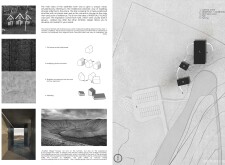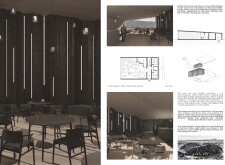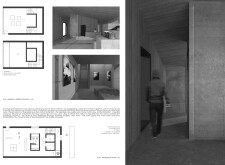5 key facts about this project
The Hverfjall Village project exemplifies a focused approach to architectural design in an Icelandic context, specifically situated near the Hverfjall volcano. The project is comprised of a series of distinct structures coordinated to facilitate various functionalities, including a coffee shop, exhibition space, and visitor pathways. Each building integrates seamlessly into the volcanic landscape, reflecting the area's cultural heritage through both form and material choice. The overarching design promotes interaction between visitors and the surrounding environment, while allowing for flexibility in use and future development.
Thoughtful Use of Materiality
An essential characteristic of the Hverfjall Village project is its deliberate choice of materials, which includes charred wood, exposed concrete, recycled steel, and glass. Charred wood serves both aesthetic and practical purposes, providing a contrast to the natural environment while enhancing durability against harsh weather conditions. Exposed concrete offers structural integrity while maintaining a modern appearance. Recycled steel contributes to the sustainability pursuits of the project by utilizing local resources. Additionally, the extensive use of glass in the buildings creates transparency, allowing natural light to enrich interior spaces and offering views of the striking landscape. This careful selection of materials underscores the project's commitment to sustainability and environmental harmony.
Integration of Design Elements
The design of Hverfjall Village incorporates unique spatial organization that differentiates it from typical architectural projects. The layout consists of interconnected pathways that mirror the natural topography around the volcanic site, encouraging exploration and interaction among visitors. The coffee shop is positioned to maximize views toward the volcano, creating a social atmosphere while blending into the environment. The exhibition space is crafted to promote engagement with the local culture and geology, enhancing the overall visitor experience. Information points are strategically located throughout the project, facilitating a better understanding of the ecological and cultural narratives associated with the site. This integration of design elements fosters a cohesive experience that prioritizes human interaction and environmental awareness.
Explore the project presentation for more details on architectural plans, architectural sections, and architectural ideas that further elucidate the design outcomes and intentions behind Hverfjall Village.


























